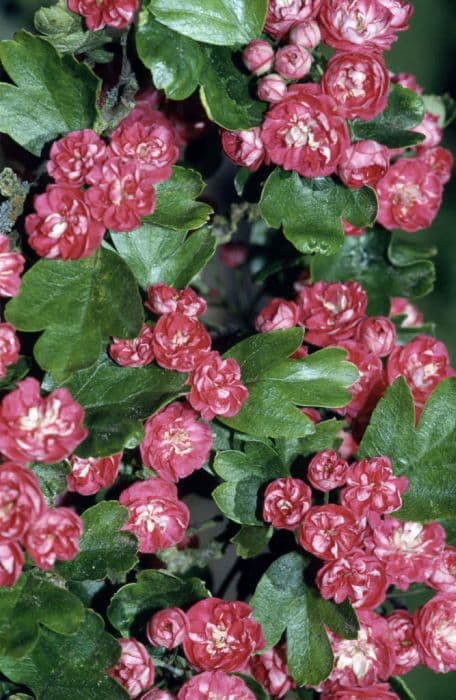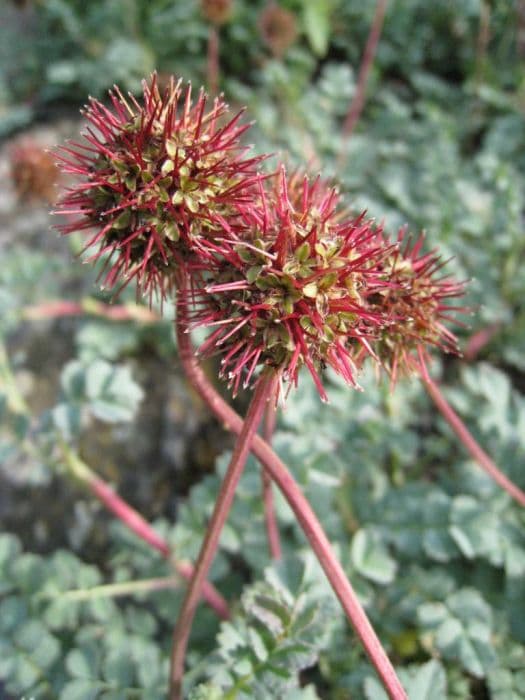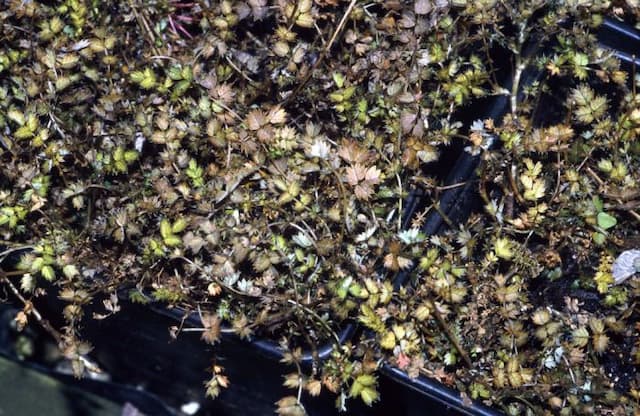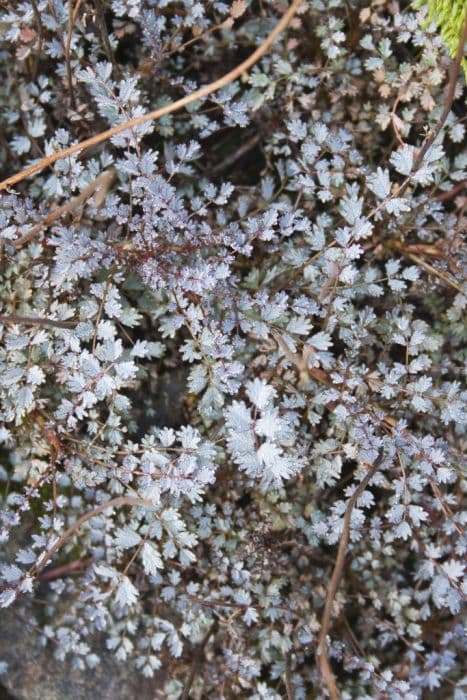Paul's Scarlet Hawthorn Crataegus laevigata 'Paul's Scarlet' (d)

ABOUT
The plant commonly known as 'Paul's Scarlet' hawthorn is a cultivar cherished for its beautiful floral display. During its blooming season, which typically occurs in late spring, the plant becomes a focal point in the landscape due to its dense clusters of double-flowered blossoms. These flowers have a deep rosy to scarlet hue, creating a vibrant splash of color that can enliven any garden space. The leaves of the 'Paul's Scarlet' hawthorn are a lustrous green, with a texture that can be described as glossy. These leaves often have a lobed appearance, giving the foliage a slightly serrated look along the edges, adding to the plant's overall decorative effect. This deciduous plant graces the landscape with a rounded and densely branched form, contributing to a rich sense of fullness in the foliage. The twigs and branches typically exhibit a pattern of thorns, characteristic of hawthorns, which can be particularly sharp and stout. This feature serves as a defense mechanism in the natural setting and should be considered when the plant is placed in areas of human activity. When not in bloom, the 'Paul's Scarlet' hawthorn's textured bark and the structure of the branches provide a natural, rugged beauty, maintaining its visual interest even in the colder months when the leaves have fallen. This handsome structure supports an overall aesthetic that is appreciated in many landscapes for its natural charm and year-round interest.
About this plant
 Names
NamesSynonyms
English Hawthorn, Midland Hawthorn, Woodland Hawthorn, Mayflower, Paul's Scarlet Hawthorn.
Common names
Crataegus laevigata 'Paul's Scarlet'.
 Toxicity
ToxicityTo humans
The plant commonly known as English Hawthorn is not generally considered highly toxic to humans. However, like many plants, certain parts of it can cause adverse effects if ingested in large quantities. The berries have been used historically for medicinal purposes at controlled doses, but eating large amounts may lead to stomach upset. The seeds inside the berries contain amygdalin, which can release cyanide when metabolized. Therefore, ingestion of significant quantities of seeds could potentially lead to cyanide poisoning, with symptoms including difficulty breathing, weakness, and possibly even coma or death in extreme cases. It is important to exercise caution and avoid consuming the seeds.
To pets
For pets, the English Hawthorn's berries can pose some degree of toxicity, primarily due to the seeds inside them, which contain amygdalin that can convert into cyanide when digested. While the flesh of the berries is less of a concern, consumption of the seeds in significant amounts by pets can lead to symptoms of cyanide poisoning. These symptoms might include vomiting, diarrhea, difficulty breathing, increased salivation, weakness, and in extreme cases, seizures, coma, or death. If you suspect your pet has ingested a large quantity of the berries or seeds, it is crucial to contact your veterinarian immediately.
 Characteristics
CharacteristicsLife cycle
Perennials
Foliage type
Deciduous
Color of leaves
Green
Flower color
Scarlet
Height
15-25 feet (4.5-7.6 meters)
Spread
15-25 feet (4.5-7.6 meters)
Plant type
Tree
Hardiness zones
5-8
Native area
Europe
Benefits
 General Benefits
General Benefits- Ornamental Appeal: Crabapple trees, such as Crataegus laevigata 'Paul's Scarlet', are popular for their beautiful double pink blossoms that bloom in the spring, offering aesthetic value to gardens and landscapes.
- Wildlife Habitat: The plant provides a habitat and food source for birds and other wildlife, which feed on its berries and use the tree for shelter.
- Drought Resistance: Once established, this crabapple variety tends to be drought resistant, making it suitable for planting in areas with water scarcity.
- Pollinator-Friendly: The flowers attract bees and other pollinators, thereby supporting local ecosystems and biodiversity.
- Seasonal Interest: 'Paul's Scarlet' has year-round interest with blossoms in spring, lush green leaves in summer, and colorful fruits and foliage in autumn.
- Compact Size: This cultivar usually remains relatively small, making it a suitable choice for residential gardens and public landscapes with limited space.
- Low Maintenance: It requires minimal pruning and care once established, making it easy for gardeners of all levels of experience.
- Hardscape Protection: Can be planted strategically to protect hardscaping features from sun or wind damage due to its canopy.
- Urban Tolerant: The variety is tolerant of urban pollution and compacted soils, making it suitable for city environments.
- Erosion Control: Its root system can help stabilize soil and reduce erosion on slopes and banks.
 Medical Properties
Medical Properties- Cardiovascular support - Hawthorn has traditionally been used to help support cardiovascular health, improving circulation and heart function.
- Antioxidant activity - Components within Hawthorn may exhibit antioxidant properties, helping to protect cells from damage caused by free radicals.
- Mild sedative - Hawthorn may exert a calming effect and is sometimes used to help reduce anxiety and promote sleep.
- Digestive health - It has also been used to aid digestion and relieve abdominal discomfort.
 Air-purifying Qualities
Air-purifying QualitiesThis plant is not specifically known for air purifying qualities.
 Other Uses
Other Uses- Hawthorn 'Paul's Scarlet' can be used in bonsai cultivation. Its small leaves and attractive flowers can create visually stunning miniature trees.
- The dense branching habit of Hawthorn 'Paul's Scarlet' makes it suitable for use as a privacy hedge or living fence.
- With proper training and pruning, Hawthorn 'Paul's Scarlet' can serve as an attractive topiary for garden art.
- The wood of Hawthorn 'Paul's Scarlet' is hard and can be used in the production of small wooden crafts and carving projects.
- During autumn, the berries of the Hawthorn 'Paul's Scarlet' can be harvested and used to make homemade natural dyes for textiles.
- The strong branches of Hawthorn 'Paul's Scarlet' can be used as support stakes in gardening for other plants that require staking.
- Florists can incorporate the flowering branches of Hawthorn 'Paul's Scarlet' into springtime floral arrangements for their vivid color.
- The tree can be planted in urban environments to add greenery as it is relatively tolerant of pollution and soil compaction.
- The dense foliage of Hawthorn 'Paul's Scarlet' can serve as a nesting site for various bird species, promoting local biodiversity.
- In landscape design, Hawthorn 'Paul's Scarlet' can be used to create dramatic flushes of color with its spring blossoms, especially when planted in groups.
Interesting Facts
 Feng Shui
Feng ShuiHawthorn is not used in Feng Shui practice.
 Zodiac Sign Compitability
Zodiac Sign CompitabilityHawthorn is not used in astrology practice.
 Plant Symbolism
Plant Symbolism- Hope - The hardy nature of the Crataegus laevigata, commonly known as the English Hawthorn, represents hope and the endurance to overcome challenges.
- Protection - Hawthorns have traditionally been planted near homes to offer protection, as their thorny nature was believed to ward off negative energies or malevolent spirits.
- Love & Marriage - With its vibrant 'Paul's Scarlet' flowers, the Hawthorn is also a symbol of love and the blossoms are often associated with spring and the renewal of relationships, hinting at marriage and fertility.
- Happiness - In some cultures, the Hawthorn tree is considered a sign of happiness, with the bright blooms bringing joy to those who behold them.
- Cleansing - The Hawthorn has been used in various traditions for purification purposes, symbolizing the removal of obstacles or negative influences.
 Water
WaterThe Midland Hawthorn should be watered deeply, allowing the soil around the roots to become moist without becoming waterlogged. During the growing season, it typically needs about 1 inch of rain per week, so supplement with watering if the weather is dry. The amount of water typically translates to around 0.625 gallons per square yard per week. However, during hot spells or periods of drought, weekly watering may need to be increased. During the winter months, reduce watering as the plant's water requirements decrease.
 Light
LightMidland Hawthorn thrives best in full sun to partial shade. Therefore, the optimal spot for this plant is one where it receives at least 4 to 6 hours of direct sunlight daily. While it can tolerate some shade, too much can lead to reduced flowering and a less robust plant.
 Temperature
TemperatureThe ideal temperature range for Midland Hawthorn is between 50°F and 80°F. It can tolerate temperatures as low as -20°F and as high as 90°F. However, prolonged exposure to temperatures outside of its ideal range can lead to stress, and proper care should be taken to protect it from extremes.
 Pruning
PruningMidland Hawthorn benefits from pruning to maintain its shape, encourage airflow, and remove dead or diseased branches. The best time for pruning is in the late winter or early spring before new growth begins. Pruning can be done annually, focusing on thinning out the center of the plant and removing any crossing or rubbing branches.
 Cleaning
CleaningAs needed
 Soil
SoilPaul's Scarlet Hawthorn thrives in well-draining loamy soil enriched with organic matter. The ideal pH for this soil mix should be mildly acidic to neutral, ranging from 6.0 to 7.5. To prepare the best soil mix, combine garden loam, peat moss, and sand or perlite in equal parts to ensure proper drainage and aeration.
 Repotting
RepottingPaul's Scarlet Hawthorn is typically grown outdoors and does not require repotting. As a tree, it's planted in the ground where it can grow without the need for repotting. However, if grown in a container as a young plant, it should be potted into a larger container only when it outgrows its current one, which is relatively infrequent.
 Humidity & Misting
Humidity & MistingPaul's Scarlet Hawthorn is adaptable to a wide range of outdoor humidity levels and does not have specific humidity requirements. It can thrive in the natural humidity provided by its environment, whether it's planted in a garden or a landscape setting.
 Suitable locations
Suitable locationsIndoor
Not ideal for indoors; requires full sun and large space.
Outdoor
Plant in full sun, well-draining soil, and water regularly.
Hardiness zone
4-8 USDA
 Life cycle
Life cycleCrataegus laevigata 'Paul's Scarlet', commonly known as the 'Paul's Scarlet' Hawthorn, begins its life cycle with seed germination, which requires a period of cold stratification to break dormancy. After sprouting, the seedling grows through a juvenile phase, developing into a small shrub with characteristic lobed leaves. With time, it matures into a flowering tree and develops clusters of double, rosy-pink flowers in the late spring, which are followed by small, apple-like fruits that may persist into winter. Throughout its life, the 'Paul's Scarlet' Hawthorn experiences annual cycles of growth with new leaves and flowers each spring, and leaf drop in the autumn. This tree can live for many decades, continuing to produce flowers and fruit each year. In its final life stage, the tree may experience reduced vitality and dieback, eventually concluding its life cycle with death and decomposition, returning nutrients to the soil.
 Propogation
PropogationPropogation time
Spring to Early Summer
Crataegus laevigata 'Paul's Scarlet', commonly known as Paul's Scarlet Hawthorn, is often propagated by grafting. This popular method typically takes place during the dormant season, in late winter or early spring. In grafting, a piece of stem containing buds from Paul's Scarlet Hawthorn is surgically joined to the rootstock of a compatible Hawthorn species. The graft union is carefully wrapped and sealed to maintain moisture and the two tissues fuse over time, combining the desirable characteristics of Paul's Scarlet's foliage and flowers with the vigor and adaptability of the rootstock. Good aftercare, such as ensuring the graft site is above ground and providing water and nutrients, is crucial for the success of this process.









